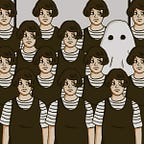L.H.O.O.Q. — Art Criticism
Artist: Marcel Duchamp
Date: 1919
Movement: Dadaism
Medium: Colored reproduction, heightened with pencil and white gouache.
Dimensions: 11 7/8 x 9 1/8 in. (30.3 x 23 cm)
Location: 1919 version — The original version is currently unknown. 1930 replica — Musee National d’Art Moderne, Centre Georges Pompidou, Paris.
“This Mona Lisa with a moustache and a goatee is a combination readymade and iconoclastic Dadaism. The original… made a very risque joke on the Gioconda.”
— Marcel Duchamp
L.H.O.O.Q by Marcel Duchamp is a significant work in the history of twentieth-century art, with its basic graffiti-like markings serving as a clear declaration of DADA’s irreverence for convention. It was originally created in 1919 with a low-cost postcard replica of Leonardo da Vinci’s famous Mona Lisa. Duchamp drew a moustache and a goatee on the sitter’s face using a pencil, presenting the new image as a stand-alone piece of art.
The phonetic pun nested within the title, which Duchamp put on the edge of the card, heightened the shocking and subversive impact of this playfully altered readymade. When read aloud in French, L.H.OO.Q resembles the phrase “Elle a chaud au cul”, which means “She has a hot arse.”, “avoir chaud au cul” is a vulgar expression implying that women have sexual restlessness. In a late interview (Schwarz 203), Duchamp gives a loose translation of L.H.O.O.Q as “There is a fire down below”.
In order to publish L.H.O.O.Q. in his magazine 391, Francis Picabia, a French Avant-Garde artist, could not wait for the piece to arrive from New York City, with Duchamp consent consent, he drew the moustache on Mona Lisa himself (forgetting the goatee). “Tableau Dada par Marcel Duchamp,” Picabia wrote beneath it. The lack of a goatee was immediately noticed by Duchamp. Duchamp fixed the omission on Picabia’s replica using a fountain pen. He sketched the goatee and wrote, “Moustache par Picabia / barbiche par Marcel Duchamp / avril 1942.”
“Gioconda was so universally known and admired”, Duchamp later explained about his choice of subject, “It was very tempting to use it for scandal.” Indeed, despite the fact that the artwork had been hanging in the Louvre since 1804, it had achieved unprecedented heights in the public consciousness following its daring robbery from the museum in August 1911. The incident made international headlines, and despite the fact that both Guillaume Apollinaire and Pablo Picasso were considered suspects in its disappearance, the police remained baffled by the crime. Over the following months, the story was widely covered in the French media, with analysts picking over every supposed sighting and fresh conspiracy idea. The Mona Lisa had become one of the most instantly known icons in French society by the time it was recovered over two years later — in the days immediately following its return to the Louvre, over a hundred thousand people are claimed to have come to see the painting, welcoming her back to the city.
Over the course of 1919, events commemorating the 400th anniversary of Da Vinci’s death sparked a spirited debate in Parisian art circles over his life and work. Well aware of his content, Duchamp utilized L.H.O.O.Q to undermine the cult of respect that surrounded the artist, taking aim at the Renaissance master’s most known artwork.
“Like Alice in Wonderland the young artist of tomorrow will pass through the looking glass of the retina to reach deeper mines of expression… to uncover new shock values which are and always will be the basis of a revolution in art.”
— Marcel Duchamp
Duchamp’s graffiti-like markings also spoke to the artist’s continuous exploration with gender identity and appearance flexibility. As he observed: “The curious thing about that moustache and goatee is that when you look at the Mona Lisa, it becomes a man. It is a woman disguised as a man; it is a real man, and that was my discovery, without realizing it at the time.”
Duchamp had granted permission to replicate works from his early career in new context on multiple occasions, despite being officially “retired” and fully devoted himself to chess by the 1960s. In 1964s, Arturo Schwarz, the artist’s close friend and scholar, arranged the publication of a poetic essay on Duchamp by French writer, Pierre de Massot entitled ‘Marcel Duchamp, propos et souvenirs.’. With the aim of producing a limited edition of 35 copies, Schwarz requested that Duchamp provide an artwork to accompany the text. The artist chose L.H.O.O.Q for the project, and 38 colors reproductions of the artwork were purchased (allowing for three examples outside the edition: one for Schwarz, one for Massot, and one for himself), which he then amended by adding the customary facial hair and a thin layer of white gouache to hide the identity of the original artist and the institution where it is housed.
Duchamp destroys the original painting’s identity and identifies L.H.O.O.Q. as an autonomous work of art in its own right.
Source:
- M. Duchamp, ‘Interview with Hubert Crehen for WBAJ-FM Radio, New York, Evidence, no. 3, Toronto, Fall 1961, pp. 36–38
- M. Duchamp, quoted in C. Thomkins, The Bride and the Bachelors: Five Masters of the Avant-Garde, New York, 1968, p. 45
- M. Duchamp, quoted in C. Thomkins, Duchamp, A Biography, New York, 1996, p. 222
- Wikimedia
